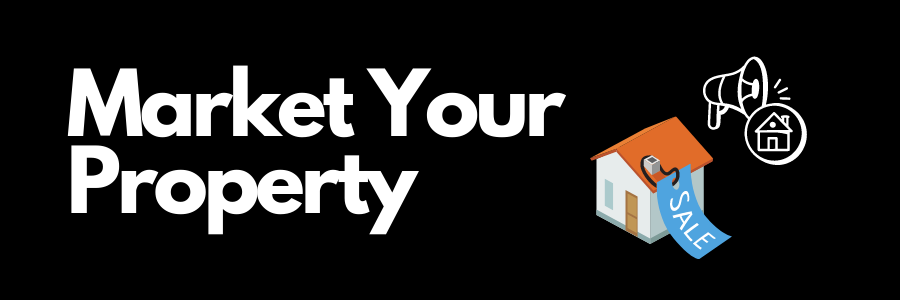
How to advertise property for sale? Detail Guide
There are several ways property can be advertised when it is up for sale. This article will provide an insight into the different methods of advertising that are available, including; online; in print media; on signs, and through letting agents.
-
Online
With the rise in popularity of the internet, more and more people use search engines to find out information about specific properties. This is why having a well-optimized website that contains lots of good quality photographs and written information, e.g. property descriptions, floor plans, etc., is so important for sellers of property.

If you cannot afford your own website then it is advisable to look into companies who offer this service, such as; Be My Guest, which offers a free website with the purchase of your advert.
Through online portals, it is possible to reach thousands, if not millions, of potential buyers. In this day and age, it is likely that the majority of people will at least look through these sites when they are in the market to buy property.
Many websites offer services free of charge for sellers wishing to advertise their own properties, though it should be remembered that this type of online advertising will only reach a very small number of people.
Social media sites such as Facebook and Twitter are also worth considering for advertising property, particularly when looking to sell through an Estate Agent, with many agents now offering a free lead-generating service on their websites. In addition, it might be worth setting up the property’s own social media page to convey property information and contact details.
-
List on Facebook Marketplace
List on Facebook Marketplace is now available countrywide. It is a free advertising platform available exclusively to those who have a legitimate UK business account and an active email address.

Listing on Facebook Marketplace allows you to create a post with a photo, which can be set as public or private. You can then choose a category for the listing and add tags to it. The listing will be visible within the Marketplace category, as well as in search results if your chosen location is one of the 150 supported cities (and you’ve chosen to make it public). Marketplace posts can also link directly to your website or Facebook business page, which makes them perfect for promoting property online.
-
Use Email Lists
If you have an existing clientele who are likely to be looking for properties during your sale, it may be advisable to send them an email with the details of what is available. This can easily be done via a smartphone or tablet, but if sending bulk emails then it is important that permission has been gained from all parties to send this information.

Being proactive is always a good idea with marketing, so why not put up some bright yellow ‘For Sale’ signs with your contact information? Making yourself visible around the local area will also give the impression that you are actively marketing the property with an intention to sell.
-
Broadcast on Facebook and Instagram Live
It is possible to broadcast the property details live on Facebook and Instagram, allowing friends and family to watch, or get involved even. Your viewers can ask questions in real-time by commenting below the video!

The entire process will be recorded through your phone camera for you to download after it has ended. This allows you to upload the footage straight away without having to film it again. This is perfect if you are pressed for time but still want to promote your property in this way!
-
In Print media
Estate Agents will often take out advertisements for property in local Magazines, Newspapers, and Trade Publications. Some people prefer to use these types of print media when selling through an Estate Agent because they feel that the printed word will appear more official than advertising online.

Estate Agents will usually send out a press pack to as many potential buyers as possible, which may include other agents as well as private individuals. Many people still prefer to view a property that is advertised in print media, even if it has been viewed online. If you are going to advertise your own property in print media then it will have to be done through an agent or via a self-adhesive sign.
-
Signs
Self-adhesive signs are an excellent way of advertising property for sale. They can be purchased cheaply from stationers, online, or at retail outlets. They are easy to put up on any flat surface and they will remain secure for months, even in windy conditions. This type of signage is often used for selling vacant property; though it is also possible to use them when the property is occupied.

Signs are very visible and people will often stop to read through the details, particularly if they live in the local area. They can be placed anywhere on your land where they will be clearly seen, e.g. at the front of the house, above the garage or at the rear. You do need to be careful about restricting access with signs though because people may start turning up on your doorstep whenever they feel like it in order to view the property.
The disadvantage of advertising through signs is that Estate Agents will not necessarily come and value your property, nor will visitors necessarily contact you about viewing.
-
Through Letting Agents
Letting Agents are usually the first port of call when people are looking for a property to rent, so it is worth advertising through them to start with. Some Estate Agents will have special deals with letting agencies that mean they can have first refusal on all the properties they have for sale that are suitable to let.

Some letting agents will require the seller to sign a document allowing them to act on behalf of the seller, this is known as an ‘agency agreement’. This will usually include things like; whether there is already a tenant in the property; how long the agency agreement is for; what the letting agents’ fees are and who will pay these fees. It is important that the seller reads this legal document carefully, taking note of any conditions they do not agree with and making sure they understand what it means before signing anything.
There are several types of letting agent deals that can be set up:
Let to Buy – where the seller will remain in occupation of the property until it has been sold.
Assured Shorthold Tenancy (AST) – this is the most common form of tenancy used when renting out a dwelling house that is separate from the owner’s residence. In this case, on completion of the sale, the parties to the AST will become the buyer (that is, the new landlord) and the tenant (that is, the new occupier).
Open Market Tenancy – this tenancy gives more protection to both parties than an AST. An open market tenancy has no assured shorthold term attached to it. Generally, but not always, this type of tenancy will be granted to a tenant who is already living in the property and has given notice that they intend to leave.
Assured Tenancy – this form of tenancy is generally more suitable for people who have been renting for some time, particularly families wanting stability. This type of tenancy can only be granted by a private landlord who owns fewer than three properties and who has not already granted an assured shorthold tenancy during the past twelve months.
Things to Keep in Mind:
-
Hire a professional photographer
The professional will know how to take the photographs in order to show your property at its best.
They will take several shots of each room, showing different angles and features that give a good impression of what the room is like. This could be the entrance hall or lounge, for example. You can ask them to take any type of photo you feel may help sell your home, e.g. some close-up shots of the front of your house or some outdoor photos to give people an idea of the surrounding area.
-
Change The Featured Photo Regularly
If you are advertising online, you can use photographs of all rooms, or perhaps areas that are popular with potential buyers, e.g. if your property is near the sea you could put one photo up showing this view to make it more appealing. If there is an attractive garden area you could also include a photograph of this.
-
Be prepared for people to knock at your door
.If you are out when they come it may be better not to answer the door as this could be off-putting for them. It is also worth remembering that some estate agents will suggest times when sellers are more likely to be home, e.g. working from home or visiting friends or relatives, so it is worth checking with your agent to see what they recommend.
-
Put a price on the property
Some estate agents will keep details of each property they have for sale in their office so they can show buyers around when they are looking for something similar to what is available. They may therefore have some idea about how much you should be charging for your home based on their previous experience selling properties with similar features in your area. They can also give you a reasonable idea of how much similar properties will sell for in the local market.
-
Describe the property accurately.
It is important to make sure you do this, especially when selling through an estate agent. You should not describe your home in a way that will mislead buyers into thinking something is included in the sale price which has to be paid extra (though it is acceptable to mention optional features if they are part of the overall contract). Make sure you know what your agent is allowed to include in their advertising.
-
Include a floor plan of the property
in the sales literature. This will make it easier for buyers to get their bearings and see which parts of the home are open to view.
-
Choose adjectives wisely
You want to give potential buyers a good idea about what your property is like, but it is both unwise and unnecessary to include personal opinions or judgments in sales pitches. “Lovely” and “charming” may be appropriate for some homes, whereas others may need more neutral adjectives such as “spacious”, “good-sized” and so on.
-
Avoid red flag words
When writing house descriptions, think about the words you are using and avoid any that could give buyers a negative idea about your home.
For example, when describing a kitchen it is important not to say “old”, which suggests the buyer may be buying a property with an old kitchen which needs replacing. “Cosy” is also a red flag word and could lead buyers to think your home is too small for them.
-
Include words that add value
Think about what makes your home special and include these words in the sales pitch to make it stand out from other properties for sale. You might want to add features such as a double glazed conservatory or brand new kitchen cabinets, for example. Be sure not to exaggerate though when you are doing this, as if necessary buyers can always ask the estate agent to arrange for a surveyor to visit your property before they make an offer.
-
Highlight unique features
If there are features of your home which buyers would really notice and appreciate if they viewed the property, such as an attractive garden, a view or a location near to public transport links, it is worth mentioning these. There will be other properties for sale with similar features so this could set you apart from the competition. It is important not to mislead buyers though, so avoid making statements which are impossible to prove.
-
Address the problems with the property head on
It is good practice to be honest about issues that you know of in your home before potential buyers realize them for themselves. These could include damp patches or cracks in walls, creaking floors and so on. Some estate agents will include this information in their sales literature but if they do not you should write it into the description of your home yourself.
Writing a good property description includes more than just telling buyers what features are available in the home and what its boundaries are. It is important to convey an impression of the atmosphere of the place, how it would suit certain people and how it is priced to sell.
Conclusion
It is important to keep in mind that buyers always have the option of arranging their own surveyor to visit your property before they make an offer. If you are able, it is good practice to recommend this if you know there are some serious problems with your home or if you think potential buyers may be unduly worried about something which actually has little bearing on the property as a whole.
In all, you want to create descriptions of your property which are accurate and informative but which also make it stand out from other properties for sale in the local market. You don’t want to make false statements or overplay issues with your home, but you do want to try and highlight its best features. This should create a good impression in the mind of potential buyers and encourage them to make an offer for your property.
